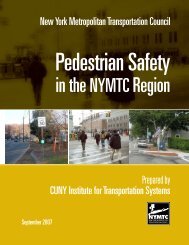Chapter 3 The Transportation System - New York Metropolitan ...
Chapter 3 The Transportation System - New York Metropolitan ...
Chapter 3 The Transportation System - New York Metropolitan ...
- No tags were found...
You also want an ePaper? Increase the reach of your titles
YUMPU automatically turns print PDFs into web optimized ePapers that Google loves.
<strong>Chapter</strong> 3• Supporting infrastructure like railyards and highway maintenancefacilities, highway rest areas, parkinglots and garages, bus depots andtransit storage yards, bicycle parkingareas, toll plazas, signage, signals,electronics, and other equipment.<strong>The</strong> NYMTC planning area also playsa major role in the national rail, road,air, and waterborne networks. Amtrak’sbusiest facility in the nation is Penn Station,which served 9,493,414 passengersin fiscal year 2012, and 77 percent ofNortheast Corridor air and rail passengersbetween <strong>New</strong> <strong>York</strong> and Washington,DC chose train travel. <strong>The</strong> PortAuthority Bus Terminal has long beenthe primary location for long-distancebus service. In addition, since the late1990s, curbside-pickup carriers haveplayed an increasing role in transportingbus passengers beyond the region.<strong>The</strong>re are four commercial service airports,including the John F. Kennedy(JFK) and LaGuardia (LGA) airports in<strong>New</strong> <strong>York</strong> City, along with several othergeneral aviation and heliport facilities ofvarying sizes that together serve millionsof passengers and ship tons of freightboth within and immediately beyondNYMTC’s borders. Finally, <strong>New</strong> <strong>York</strong>and <strong>New</strong> Jersey remain significant portregions that are essential to internationaltrade and domestic distribution with oneof the largest concentrations of publicand private marine terminal facilities inthe United States.Although not a part of the NYMTCplanning area, northern <strong>New</strong> Jersey’sand southwestern Connecticut’s transportationinfrastructure is inextricablylinked with <strong>New</strong> <strong>York</strong>’s. In January2008, a Memorandum of Understanding(MOU) was created in the three state regionof <strong>New</strong> <strong>York</strong>, <strong>New</strong> Jersey and Connecticutin order to better coordinatetransportation planning activities. <strong>New</strong>Jersey Transit has an extensive network ofcommuter rail, light rail and bus services,much of which enters the NYMTCplanning area. <strong>New</strong> Jersey’s highways interfacewith <strong>New</strong> <strong>York</strong> at six bridges andtunnels, along with roads which cross thestate line into Rockland County. Connecticutfunds the majority of Metro-North’s <strong>New</strong> Haven Line operations, aswell as crucial bus routes such as the I-Bus linking Westchester and Connecticutdestinations. Numerous roads alsocross the state line, and ferries regularlycross from Connecticut to <strong>New</strong> <strong>York</strong>destinations.Federally Supported <strong>Transportation</strong><strong>System</strong>A major focus of Plan 2040 in terms ofassessment of needs and allocation ofresources is that portion of the regionaltransportation system which receivesboth Federal Highway Administration(FHWA) and Federal Transit Administration(FTA) aid. For the highwaysand bridges network that would includeover 19,000 lane-miles of interstates,freeways, parkways, expressways, arterialhighways and streets. <strong>The</strong> FunctionalClassification of roadways (discussed laterin this chapter) is an important factorin identifying roadways that are eligiblefor federal aid. It also describes the importanceof a particular road or networkof roads to the overall system and, therefore,is critical in assigning priorities toprojects and establishing the appropriatehighway design standards to meet theneeds of the traffic served. In terms ofbridges the federally supported systemincludes over 2400 bridges of all typesunder the ownership of the State, countiesand local municipalities.<strong>The</strong> federally supported portion of thetransit system includes qualifying equipmentand other infrastructure ownedand operated by the various agencies inthe region including the MTA (all agencies),NYCDOT, Nassau, Suffolk, Putnam,Westchester, and Rockland Counties.<strong>The</strong>se are described in the financialsupporting documentation in Appendix10.This chapter reviews all of these elements,including recent major eventsand trends, and their impacts on theNYMTC planning area. Also presentedare a number of operational data tablesfor the various transportation entities.<strong>The</strong> <strong>Transportation</strong> <strong>System</strong> 3-5
















